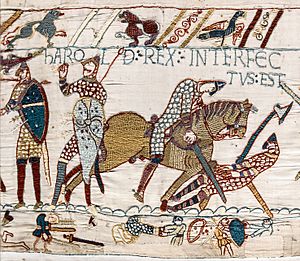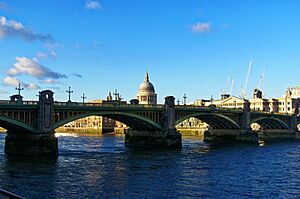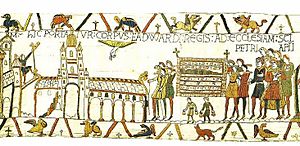Ansgar the Staller facts for kids
Quick facts for kids
Ansgar the Staller
|
|
|---|---|

Death of Harold at Hastings, October 1066;
|
|
| Portreeve of London | |
| In office 1044 (assumed) – 1075 |
|
| Monarch | Edward the Confessor; Harold Godwinson |
| Sheriff of Middlesex | |
| In office 1044 (assumed) – 1075 |
|
| Staller, Royal Official | |
| In office ca 1044 – 1066 |
|
| Personal details | |
| Born | circa 1024-1030 Unknown |
| Died | circa 1085 Normandy |
| Nationality | English |
| Parent | Aethelstan (?-after 1045) |
| Occupation | Anglo-Saxon Royal retainer, landowner, soldier |
| Military service | |
| Commands | London, October-December 1066 |
| Battles/wars | Hastings, Southwark, London Bridge |
Ansgar the Staller (also known as Esegar) was a very rich and powerful noble in England a long time ago. He lived from about 1025 to 1085. He was badly hurt at the Battle of Hastings in October 1066. After that, he bravely led the defense of London.
His family came from Denmark. They owned a lot of land in the Thames Valley, and also in Perivale and Northolt near London. In 1044, Ansgar took over from his father as the main official for London, called the Portreeve. He also became the Sheriff of Middlesex. King Edward the Confessor also made him a "Staller". This was a special title for important people in the king's household.
Ansgar worked for King Edward for many years. When Edward died, Ansgar supported Harold Godwinson to be the next king. He did not support William the Conqueror. After Harold died at Hastings, Ansgar supported Edgar Ætheling. Edgar was chosen as king by the English leaders, but he was never crowned.
Ansgar successfully stopped two attacks on London. But then, other English leaders accepted William as king. So, Ansgar also joined William's side. However, Ansgar was very powerful and had strong connections to Denmark. This made William see him as a danger. Ansgar was arrested in 1075. His lands were given to William's supporters. He died in Normandy around 1085.
A group called the Ansgar Freemason Lodge was started in 1931 in Middlesex. It was named after him.
Ansgar's Important Roles
Ansgar's grandfather, Tovi the Proud, was a Danish noble called a thegn. He came to England with King Cnut the Great. Tovi received a lot of land in Oxfordshire and Middlesex. Ansgar's father, Athelstan, was born before 1020. He worked for King Harthacnut, who was King of Denmark and England.
After Harthacnut died, his half-brother, Edward the Confessor, became king in 1042. Edward was supported by Earl Godwin. London was an important city for trade. It was mostly controlled by Anglo-Danish people, like Ansgar's father, Athelstan. Athelstan was the Portreeve of London and Sheriff of Middlesex.
In 1044, Athelstan was involved in a plan against King Edward. He lost some of his land. But King Edward did not want to make such a powerful family angry. So, Ansgar received his father's titles. Ansgar was also made a "Staller". This was a special title for senior officials in the king's household.
We don't know many details about Ansgar's life for the next twenty years. But he seemed to serve King Edward faithfully. Edward died in January 1066. Ansgar was part of a group of powerful nobles who supported Edward. They were called "stallers" and included Eadnoth and Bondi. In 1065, Ansgar and other stallers were called Royal stewards.
England in 1066
When King Edward died, Harold Godwinson was supposed to be the next king. But he had many rivals. The most important were Harald of Norway and William, Duke of Normandy. All three had strong supporters in England.
Harold's brother, Tostig Godwinson, had been sent away from England. He asked Harald of Norway for help. Tostig and Harald agreed to attack England together. In June, Tostig raided southern England. He made it seem like an attack from Normandy was coming. Then he sailed north. Harold and most of his army stayed in the south.
On September 8, Tostig met Harald in Tynemouth. Harald had a huge army of 10,000 to 15,000 men. Harold marched north, leaving Ansgar to protect London and the south. Some people think Harold didn't fully trust Ansgar because of his Danish background. Harold won a big victory at Stamford Bridge on September 25. But William landed at Pevensey on September 28. This forced Harold to rush back south with his army.
There is some debate about whether Ansgar was at the Battle of Hastings on October 14. One idea is that he was badly hurt but got away. Another idea is that he stayed in London.

Even though William won the battle, his position was still not safe. Ansgar played a key role in meetings with other English leaders. They waited for William to arrive. On October 15, Edgar Ætheling, who was only 15, was chosen as king by the English council. London had many people who supported William. But Ansgar gathered a strong army to defend the city. William supposedly offered Ansgar a place on his council and let him keep his lands.
Ansgar refused William's offer. Some say he was just trying to buy time to make his defenses stronger. This is not fully confirmed. Ansgar's defense of Southwark in mid-October stopped William from entering London. William had to march west to find another way to cross the river. Ansgar also stopped another attack on London Bridge in early December. But then, Edgar's main supporter, Edwin, Earl of Mercia, switched sides. Edgar then gave up to William. William was crowned king on December 10.
What Happened Next
Ansgar had no choice but to surrender. He seemed to keep his lands at first. He might have even helped stop a Danish revolt in 1069. But Ansgar was still too powerful for William. He was arrested in 1075. Later, he was moved to Normandy, where he died around 1085. His property was taken away and given to Norman nobles. These included Geoffrey Alselin and Geoffrey de Mandeville. Mandeville also became the Portreeve of London and Sheriff of Middlesex.
Some people think that East Garston in Berkshire was once called "Esgarston," meaning "Esegar's Estate." In 1931, the Ansgar Freemason Lodge in Middlesex was named after him. They wanted to remember him as "a hero, who died in the cause of his King, his Country and his Province of Middlesex."
Sources
- Kazhdan, A. (1991). "Komes tou Staulou". The Oxford Dictionary of Byzantium. Oxford and New York: Oxford University Press.



